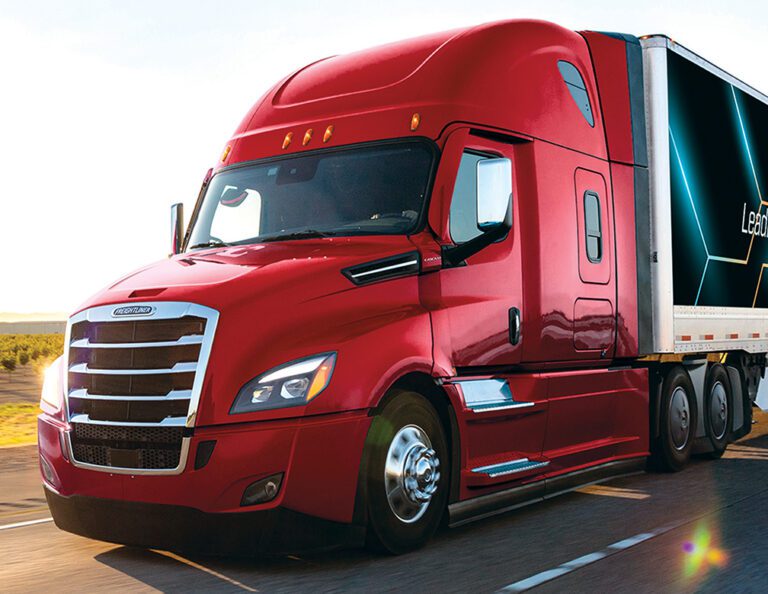April 2023 sales of new Class 8 trucks on the U.S. market were the highest since 2006 and represented the second-best April of the century to date, according to data received from Wards Intelligence. Sales for the first four months make 2023 the best first third of the year in the past 17 years.
Manufacturers reported sales of 22,741 Class 8 trucks in April — down 8.4% from March’s 24,823 but up a solid 19.4% over April 2022 sales of 19,052.
How long the high sales numbers will last is hard to predict, but Kenny Vieth, president and senior analyst at ACT Research thinks conditions will deteriorate later this year.
“We’ve spent most of the past year warning about a potential recession. Admittedly, the economy has proven more resilient than initially envisioned,” Vieth said in a statement accompanying ACT’s latest North American Commercial Vehicle OUTLOOK.
“That said, we think broader economic conditions are softening, and we reiterate our cautious view, including our forecasts for slowing 2H’23 production rates,” he continued. “We continue to expect a shallow recession to materialize, centered on mid-year.”
The OUTLOOK report cites lower freight volumes and rates and higher borrowing costs due to increased interest rates as headwinds to profitability. As profits shrink, carriers buy fewer new trucks.
This is already happening, based on preliminary Class 8 order numbers released by ACT. In the North American market, orders for new Class 8 equipment fell by 39% from March orders and by 27% from April 2022 order numbers — a clear sign carriers are more skittish about investing in new equipment to grow their fleets.
As recently as November 2022, the backlog of ordered trucks was high enough for 11 months of production, but ACT now expects that backlog to be completely gone by the end of 2023 as new orders continue to dwindle and cancellation rates of existing orders increase. Carriers will continue to order trucks to replenish their fleets as older trucks are removed but fleets aren’t likely to be expanding, given current conditions.
If there’s good news, it’s in the used truck market, where wholesale used truck deals increased by 130% in a possible sign that dealers are acquiring more inventory. Compared with March, the average price of a Class 8 used truck fell 6% in April to $68,500, according to ACT’s latest State of the Industry: U.S. Classes 3-8 Used Trucks report. That price is 32% lower than the industry peak reached in April 2022.
Used truck prices should continue falling as inventory grows. Unfortunately, lower prices may be offset by the increased cost of credit as interest rates rise. And, with lower freight rates available, the timing to purchase a truck or upgrade an older one is not good.
Moving to individual manufacturers, International posted some interesting sales numbers for April. The manufacturer’s sales of 3,046 were down 26.7% from an outstanding March, the largest percentage drop of any of the OEMs. In fact, the month-over-month decline in sales of 1,108 trucks represented over half (53.2%) of the decline of 2,082 experienced by the entire industry. Those numbers are skewed, however, by the excellent March experienced by International, which reported sales of 4,154.
Compared with April of last year, however, International showed the largest increase of all the OEMs at 59.4%. Even more impressive is the increase for the first four months of the year — 61.9%, more than twice the increase of the next-closest competitor. International’s share of the U.S. Class 8 market has grown too, from 11.1% as of March 31, 2022, to 12.5% by the end of 2022 to the current 14.2% of Class 8 sales. In April 2022, the company was the fourth-largest seller by volume; this year, it’s the second largest. New leadership and resources since International’s 2021 acquisition by the Traton Group have rejuvenated the company.
Freightliner remains the “big dog” among the manufacturers. April sales of 8,580 were down 6.8% from 9,208 in March, but 25.5% higher than April 2022, when the company sold 6,837 Class 8 trucks. The company still sold 39.4% of the Class 8 trucks sold on the U.S. market for the year to date, up 0.5% from 38.9% as of April 2022.
Volvo reported sales of 2,549 in April, up 10.2% from March and 5.1% from April of last year. Year to date, the company is 12.8% ahead of where it was last year, even as its share of the market dropped to 9.8% from 11%.
Mack sales of 1,526 in April was an 11.1% decline from March but were 6.1% better than April 2022. For the year to date, however, Mack sales have increased 28.3% from the same point last year, and Mack’s share of the market for 2023 has increased slightly to 6.4%.
Kenworth sales of 3,191 in April were down 5% from March sales but up 23.3% from April 2022. For the year to date, Kenworth sales have increased 21.1% as its market share dropped from 14.3% to 13.7%.
Sibling Peterbilt saw a sales decline in April to 3,318 trucks, down 3.3% from March sales but up 4.6% from April of 2022. Year-to-date sales are up 16.3% at Peterbilt, while the OEM’s market share has dropped from 15% to 13.8% this year.
Western Star reported sales of 491 in April, down 19.5% from March’s 610 and down 26.7% from the 670 sold last April. The company’s market share of 3.4% last April fell to 2.5%.
In considering the relationship between sales numbers and market share, it’s important to note that sales for all the OEMs — the entire market — increased by 26.5% from April 2022. An individual manufacturer could increase sales but if that increase is smaller than the 26.5% industry average, market share will decline.
Tesla reported sales of another 30 battery-electric trucks in April to bring its 2023 total to 105. If any other electric vehicle manufacturers are selling heavy-duty trucks, the numbers are not reflected in the Wards data.
Waiting for the coming recession to hit is something like seeing “Road Construction Ahead” signs and wondering how long it will be before we reach the worst of it. On the bright side, the new road on the other side might make for smooth driving.
Cliff Abbott is an experienced commercial vehicle driver and owner-operator who still holds a CDL in his home state of Alabama. In nearly 40 years in trucking, he’s been an instructor and trainer and has managed safety and recruiting operations for several carriers. Having never lost his love of the road, Cliff has written a book and hundreds of songs and has been writing for The Trucker for more than a decade.








